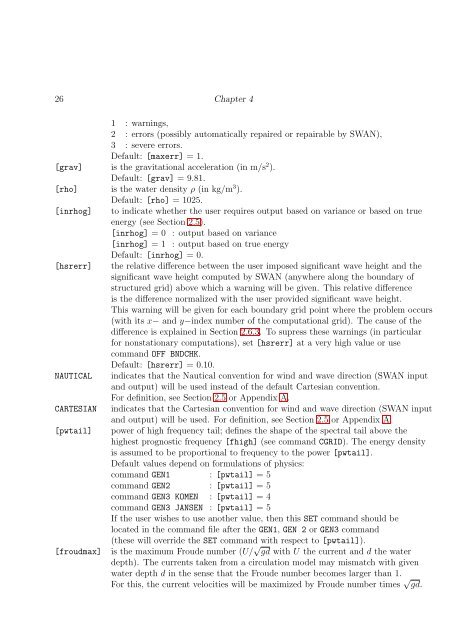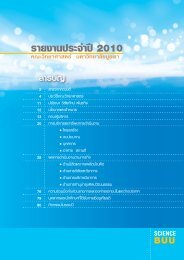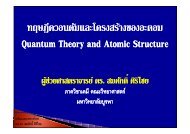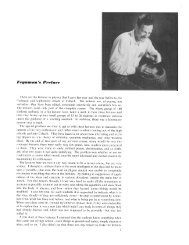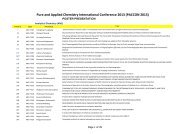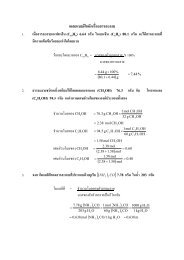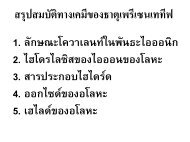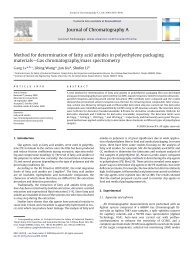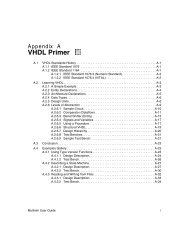USER MANUAL SWAN Cycle III version 40.72A
USER MANUAL SWAN Cycle III version 40.72A
USER MANUAL SWAN Cycle III version 40.72A
You also want an ePaper? Increase the reach of your titles
YUMPU automatically turns print PDFs into web optimized ePapers that Google loves.
26 Chapter 4<br />
1 : warnings,<br />
2 : errors (possibly automatically repaired or repairable by <strong>SWAN</strong>),<br />
3 : severe errors.<br />
Default: [maxerr] = 1.<br />
[grav] is the gravitational acceleration (in m/s 2 ).<br />
Default: [grav] = 9.81.<br />
[rho] is the water density ρ (in kg/m 3 ).<br />
Default: [rho] = 1025.<br />
[inrhog] to indicate whether the user requires output based on variance or based on true<br />
energy (see Section 2.5).<br />
[inrhog] = 0 : output based on variance<br />
[inrhog] = 1 : output based on true energy<br />
Default: [inrhog] = 0.<br />
[hsrerr] the relative difference between the user imposed significant wave height and the<br />
significant wave height computed by <strong>SWAN</strong> (anywhere along the boundary of<br />
structured grid) above which a warning will be given. This relative difference<br />
is the difference normalized with the user provided significant wave height.<br />
This warning will be given for each boundary grid point where the problem occurs<br />
(with its x− and y−index number of the computational grid). The cause of the<br />
difference is explained in Section 2.6.3. To supress these warnings (in particular<br />
for nonstationary computations), set [hsrerr] at a very high value or use<br />
command OFF BNDCHK.<br />
Default: [hsrerr] = 0.10.<br />
NAUTICAL indicates that the Nautical convention for wind and wave direction (<strong>SWAN</strong> input<br />
and output) will be used instead of the default Cartesian convention.<br />
For definition, see Section 2.5 or Appendix A.<br />
CARTESIAN indicates that the Cartesian convention for wind and wave direction (<strong>SWAN</strong> input<br />
[pwtail]<br />
and output) will be used. For definition, see Section 2.5 or Appendix A.<br />
power of high frequency tail; defines the shape of the spectral tail above the<br />
highest prognostic frequency [fhigh] (see command CGRID). The energy density<br />
is assumed to be proportional to frequency to the power [pwtail].<br />
Default values depend on formulations of physics:<br />
command GEN1 : [pwtail] = 5<br />
command GEN2 : [pwtail] = 5<br />
command GEN3 KOMEN : [pwtail] = 4<br />
command GEN3 JANSEN : [pwtail] = 5<br />
If the user wishes to use another value, then this SET command should be<br />
located in the command file after the GEN1, GEN 2 or GEN3 command<br />
(these will override the SET command with respect to [pwtail]).<br />
[froudmax] is the maximum Froude number (U/ √ gd with U the current and d the water<br />
depth). The currents taken from a circulation model may mismatch with given<br />
water depth d in the sense that the Froude number becomes larger than 1.<br />
For this, the current velocities will be maximized by Froude number times √ gd.


